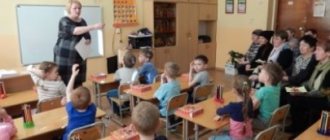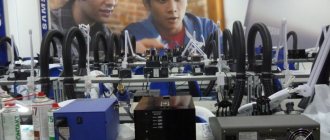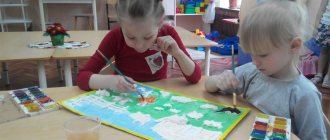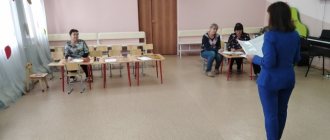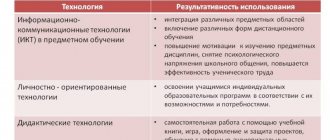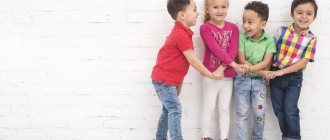Self-education report
—
Selection of illustrative material for classes and for the design of stands, groups, classrooms (scanning, Internet, printer, presentation).
— Selection of additional educational material for classes.
— Exchange of experience, acquaintance with periodicals, developments and ideas of other teachers.
— Creating presentations in the PowerPoint program to increase the effectiveness of educational activities with children.
— Using presentations created in the PowerPoint program to improve the pedagogical competence of parents in the process of holding parent-teacher meetings.
It's no secret that the material that is interesting to the child is well absorbed.
Multimedia presentations make it possible to present educational and developmental material as a system of vivid supporting images filled with comprehensive structured information in an algorithmic order. In this case, various channels of perception are involved, which makes it possible to embed information not only in factual, but also in associative form in the memory of children.
The use of computer slide presentations in the process of teaching children has the following advantages:
– implementation of polysensory perception of material;
– the ability to demonstrate various objects using a multimedia projector and projection screen in a greatly enlarged form;
– combining audio, video and animation effects into a single presentation helps compensate for the amount of information children receive from educational literature;
– the ability to demonstrate objects that are more accessible to the intact sensory system;
– activation of visual functions, visual abilities of the child;
– computer presentation slide films are convenient to use for displaying information in the form of printouts in large font on a printer as handouts for classes with preschoolers.
In a playful way, you can introduce children, for example, to sounds using S. Marshak’s “Fun ABC”, or show the sounds that a person makes. Using "Fun Counting" helps your child learn to count more easily. And how necessary are presentations when getting to know the world around you? The topics “Shoes”, “Vegetables”, “Fruits”, “Animals and their young” will not only demonstrate some phenomena or objects, but also recreate the necessary auditory associations. Presentations using riddles are also very interesting. They help develop the child’s attention, imagination, and thinking.
For a preschool child, play is a leading activity in which the child’s personality is not only manifested, but, above all, formed and developed. And here the computer has ample opportunities, because educational computer games can be used both in group work and in individual work. These can be educational and developmental games. Their use promotes the development of sensorimotor functions; increasing the effectiveness of children's learning, developing intellectual and creative capabilities. To develop healthy habits in children, you can use presentations on poems by children's poets, for example, “Magic Words” by M. Druzhinina.
Report on the topic “Self-education of primary school teachers”
Report on the topic of self-education
Primary school teacher
BELOTSERKOVETS G.SH.
2014-2015 academic year
Konstantinovskaya secondary school
Learn from those you love.
The initial stage of education is the foundation for a person’s mental development, for the formation of moral principles; talents and abilities first appear here. Everything here is very important and there are no trifles, starting from the material and technical base of training and education, the presence of warmth, comfort, home environment at school and ending with the attention and care from everyone who is older.
I have been working at school for 29 years, of which 29 years as a primary school teacher.
I have: highest category
Awarded: certificates of honor and letters of gratitude, diplomas.
I believe that modern primary education can only be effective with the maximum development of the mental activity of junior schoolchildren and their creative abilities, therefore the goal of my work is ( Theme of self-education):
“The use of key competencies as one of the factors in improving the quality of knowledge of junior schoolchildren.”
TARGET:
- formation of communicative competencies in the process of teaching primary schoolchildren.
- Studying theoretical developments on this issue, increasing the effectiveness of teaching, developing new pedagogical techniques and methods.
- Development of material for testing in lessons for diagnostic purposes. Improving the quality of teaching and education at school directly depends on the level of training of teachers. It is undeniable that this level must constantly increase, and in this case, the effectiveness of various advanced training courses, seminars and conferences is small without the process of self-education of the teacher. Self-education of a teacher is a necessary condition for the professional activity of a teacher. Society has always placed, and will continue to place, the highest demands on teachers. In order to teach others you need to know more than everyone else.
I have been working on the topic for the second year - studying literature on the problem and existing experience. Studying theoretical material
1. Methodological innovations
2. Programs and textbooks
3. Lecture materials for courses for primary school teachers
4. Attending classes with colleagues
5. Developing lessons by topic
6. Study of regulatory documents.
A developing society, as emphasized in the “Concept of Modernization of the Republic of Kazakhstan,” needs modernly educated, moral, enterprising people who can make decisions independently..., predicting their possible consequences, are characterized by mobility..., are capable of cooperation..., have a sense of responsibility for the fate of the country, its socio-economic prosperity."
By order of the Ministry of Education and Science of the Republic of Kazakhstan, the state educational standard for basic general education is the second generation standard. The standard establishes requirements for the results of students mastering the basic educational program of basic general education: personal, meta-subject, subject.
The new generation state standards place emphasis on developing the independence of educational activities of primary school students. The requirements for a graduate imply not only that students master subject knowledge, skills and abilities, but also various methods of activity that are the basis of key competencies: at the first stage of training it is important to lay the foundations of readiness to solve problems, readiness for self-education, readiness to use information resources, communicative competence.
| Work has been carried out on: - Formation of learning competencies in students through conscious independent cognitive activity in the classroom. — Planning work with capable students and low-achieving children. — Preparing students to participate in competitions — intellectual marathon and “Akbota” “Russian Bear Cub”, “Altyn Asyk”, “Kangaroo” — A week of teachers of the highest category was held “Lesson effectiveness is the result of active student activity” — Developed and applied competency-based tasks in lessons on world knowledge and literature. (information competence) -Prepared speeches at primary school education on the issues of teaching competencies “Formation of the skill of fluent conscious reading”; “The role of adjectives in speech”; “Formation of communicative competence of junior schoolchildren based on the organization of creative activities in the classroom literary reading." – In the creative group, design and submission of lesson development, extracurricular activities using competency-based tasks in primary school subjects. Winner in the nomination (2nd place) “Best educational and methodological manual for organizing CSR” Working on the implementation of a personal plan for self-education: took part in the regional competition “Best scenario for extracurricular activities” - winner in the category - 1st place; On December 23, 2013, at the JSC NCPC “Orleu” Institute for Advanced Training of Pedagogical Workers in the Pavlodar Region, competitions were held among teaching staff of schools in the region for the best CSE teacher, for the best innovative project, for the best teaching aid for conducting collective classes. In the nomination “Best educational and methodological manual”, 2nd place – a manual for primary school. — Participation (monthly) in the experimental work “Pedagogical workshop of IPK PC” Of course, the most effective way to show the results of teacher creativity is to post materials on the Internet “Portal for teachers. Magazine website, online portfolio of teachers” - 34 works. My children and I actively write articles and notes for the newspapers of the republican “Friendly Guys”, the regional “Your World”, “Ustazdar”, and the regional “Rural Weekdays” publishing house. |
Completed the courses “Activity-oriented approach to improving the professional skills of a teacher” PSPI
A primary school cannot remain aloof from the use of information teaching aids: ICT provides the teacher with ample opportunities in preparing, organizing, conducting a lesson and monitoring the educational activities of students, helps make educational material accessible to understanding, and activates the cognitive activity of students. Helps conduct lessons at a higher emotional and aesthetic level, conduct training in the zone of proximal development; over the course of the year, more than 30 lessons were conducted using an interactive whiteboard. These are Paver Point presentations with animation and music, simulators in mathematics and the Russian language, an electronic series of lessons in mathematics, the Russian language, and the surrounding world. When testing students' knowledge, various test tasks help to track the dynamics of the child's development and analyze progress. At the beginning of the last academic year, having started work on the new standard, I realized the task of becoming a construct of new pedagogical situations, new tasks aimed at using generalized methods of activity and creating students’ own products in mastering knowledge. Therefore, I focused on studying and developing competency-based tasks.
I have identified a range of tasks that I will need to solve:
1. Study in more detail the essence of the competency-based approach in education.
2. Learn to recognize competency-oriented tasks.
3. Learn to use competency-oriented tasks when working with children.
4. Learn to develop competency-oriented tasks.
5. Collect a didactic collection of materials.
6. Find and select materials for further methodological work with teachers on this topic.
7. Find like-minded people among colleagues at school.
8. Share your experience and get acquainted with the experience of your colleagues.
Of course, I couldn’t solve all the problems in one year. But I had already figured out the structure of the CAP, held a seminar on this issue for teachers at my school, and began to actively use them in my lessons.
Let me note that competency-oriented tasks change traditional approaches to the lesson. They are based on knowledge and skills, but require the application of accumulated knowledge in practical activities, since the purpose of competency-oriented tasks is to “immerse” students in solving a “life” problem.
A competency-based task is
firstly, an activity task;
secondly, it models a practical, life situation;
thirdly, it is based on material that is relevant to students;
fourthly, its structure is determined by the following elements:
Stimulus (immerses you in the context of the task and motivates you to complete it).
Task statement (precisely indicates the student activity required to complete the task).
Source of information (contains information necessary for the student’s successful performance in completing the task).
Verification tool (sets methods and criteria for evaluating the result).
Examples of competency-oriented tasks I have developed for understanding the world in 3rd grade, competence: informational, aspect: extraction of primary information.
I want to emphasize that competency-oriented tasks
included by the authors in textbooks for primary school students. However, they are not enough. Therefore, it is necessary to attract additional sources: Internet resources, various educational aids. In addition, there is an IPK PC in Pavlodar, one of the areas of work of which is the creation of a set of teaching aids aimed at developing meta-subject skills. She also took part in the work of a creative workshop.
A teacher who has mastered the structure of a competency-oriented task can successfully compose such tasks himself, including by involving his students in this.
I began my work after, during 2013, I developed a collection of competency-based tasks (information) on understanding the world. The results of the initial diagnostics showed that my students cope better with tasks on finding information in the text, applying specific subject knowledge and tasks on erudition. Tasks that required finding information in tables, figures, and diagrams made it difficult for students; reflection and assessment, application of self-organizational skills. Here's some research data:
Table 1
Research results
| Testable skills (9 students) | Starting diagnostics (% of tasks completed) november | Final diagnostics (% of tasks completed) May |
| Reading, working with text (Bold round) | 36% | 60% |
| Problem Solving Competence (Smart Round) | 72% | 76% |
| Regulatory UUD (Nimble Round) | 56% | 64% |
| Cognitive and communicative UUD (Quick round) | 50% | 72% |
Understanding full well that the student’s workload cannot be increased, I decided to use competency-oriented tasks in the educational process. I decided for myself that such tasks should be present in my lessons at least 3 times a week. At the same time, educational subjects could be different: mathematics, literacy and literary reading, technology, the world around us. The condition for including a competency-oriented task was, first of all, the content of the lesson and the type of lesson. By the end of the school year, I had about 50 assignments in various subjects. I focused mainly on tasks on working with text, graphs, tables, as well as on the development of cognitive and communicative learning skills.
In May, I conducted a repeated study of meta-subject learning outcomes for my students. The table shows positive dynamics for all tested learning tools, but the greatest increase is observed in reading and working with text and cognitive and communicative learning skills, as a result of targeted work.
Overall, I am satisfied with the results obtained, since only 1 year of my work has passed. This academic year I plan to expand the scope of application of competency-oriented tasks in the training and development of my students.
So, modern education sets a high standard for teachers in raising and teaching children. It is impossible to achieve good results at work without expressing yourself as an individual, without developing and without striving to comprehend new things. The most important thing is the teacher’s desire to work on himself and the teacher’s ability to create, learn, experiment and share his knowledge and experience acquired in the process of self-education.
Bibliography
1. V.I. Blinov, I.S. Sergeev, How to implement a competency-based approach in the classroom and in extracurricular activities: A practical guide. – M., 2007.
2. M. Demidova Competency-oriented tasks in science education. Public education. – 2008. No. 4
3. The concept of modernization of Russian education https://www.edu.ru
4. Youth Development Center of Yekaterinburg https://www.cerm.ru
Self-education report, methodological development
REPORT
on the topic of self-education of teachers of Russian language and literature Abramova A.V., Livada G.F. (meeting of the school’s methodological council together with methodological associations of teachers of the humanities, natural sciences and mathematics cycles)
(December 20, 2020)
Introduction.
Presenter: Dear colleagues! Thank you for responding to our invitation and coming to participate in our event.
The procedure for conducting a self-education report requires compliance with certain rules.
1) Presentation of the teacher, justification of the topic of self-education, forms of self-education.
Teacher of Russian language and literature, Galina Fedorovna’s work experience is more than 30 years, Anna Viktorovna’s is more than 40 years. I will immediately focus on the form of our work on self-education. This is a technological couple. The peculiarity of this form of teacher training is that the technological pair is a voluntary choice of the teacher and his business. In general, this form of advanced training is new, and there must be conditions for organizing advanced training in this form, these include:
Abramova A.V.:
-Continuity of the educational program (we work according to the program of Razumovskaya M.M.)
- interest in the result of the work
- similar or close type of thinking
Livada G.F.:
-Professional and psychological compatibility
- the ability to listen to a truthful assessment of your work, strive to correct methodological errors
- do not blindly follow other people’s experience, but adapt other people’s experience to your own working conditions and the needs of children.
Presenter:
Of course, we can say that a teacher who has worked for more than 30 or 40 years may not need self-education at all. The simplest technique will help you understand the opposite: dear colleagues, draw a circle, an oval of such a volume that, in your opinion, corresponds to the scope of your professional knowledge and skills. Galina Fedorovna, draw such an oval. Anna Viktorovna, draw an oval or a circle. You see that the larger the circle, the wider the lines that mark its boundaries - and this is the area of \u200b\u200bignorance. The conclusion is simple and clear: it’s never too late to learn, even if you have experience and a wealth of not only knowledge, but also self-confidence.
Galina Fedorovna:
We believe that our experience is, in principle, equivalent in content - there are significant advantages and significant disadvantages. What do we consider advantages?
1). Sufficiently deep knowledge of the content of the subjects. I note that literature is a subject that is simply impossible to know perfectly; of course, the teacher’s knowledge is much more voluminous and deeper than the content of the school literature curriculum. And the modern Russian language is a constantly changing phenomenon, so to say that I know my subjects perfectly means to show limitedness to some extent.
Anna Viktorovna:
2). Knowledge of traditional (long-term) teaching methods.
3). The ability to choose the correct (in one’s own opinion) pedagogical and methodological solutions necessary in a particular situation (alas, there are many mistakes).
4). In general, mastery of classes and lesson organization (there are few unfinished, disrupted lessons).
The analysis showed us the disadvantages of the experience:
1). We know a lot, but we don’t want to learn anything more.
2). The exam results are not bad, why change anything.
Galina Fedorovna:
I would like to dwell on the topic of our self-education: “Interactive teaching techniques.” The topic is not new, and seems to be well known to everyone. A more modern option is educational technology. The natural question for us was: “Why then study such a simplified topic as interactive techniques?” We started analyzing our self-education with the question “What are interactive teaching techniques?” It turns out we know, but not very well. The scientific language gets in the way; it is impossible to understand the labyrinths of formulations. We needed clear answers and found them on the Internet:
Abramova A.V.
The first answer is the teacher’s – you can agree and disagree with it; in this definition it is difficult to distinguish between techniques, methods and forms. We have highlighted the most important thing, in our opinion. Interactive learning technologies: - this is an organization of the learning process in which it is impossible for the student not to participate in a collective, complementary learning process based on the interaction of all its participants. Technologies provide the exchange of knowledge, ideas, ways of working, joint problem solving, and comfortable learning conditions. The most effective, in my opinion, are: work in pairs, work in small groups, carousel, brainstorming, role-playing (business) game, discussion, dialogue method. I try to use all these technologies in my practice, because they allow me to think critically, find ways to solve problems, and help everyone express their point of view.
Livada G.F.
I liked this answer the most: especially the highlighted part of it (spelling and punctuation preserved):
from the word interactive - interacting. a system that exchanges information in both directions, for example. for example, a regular textbook can only be read, i.e., receive information from it, but when working with an interactive training program, the user can perform some actions himself and receive an answer to them
It is also interactive, in other words, “having a response.” Responsive. Interaction here and manipulation mean something that can be influenced. What answers you in response to your action (as a rule, you are the leading party). Like water or glass (let’s take interactivity in games, where it seems to have come from, for example) someone threw a stone, the water made splashes and waves, and the glass cracked or broke. This is interactivity. Non-interactive is when there are no consequences from an action or
they are extremely insufficient (the stone simply sank in the water or flew off the glass without affecting them in any way). In general, “inter” in this case means “mutually”, and “activity” is “activity”, that is, interaction is obtained. As far as software is concerned, the term “feedback” is commonly used.
Abramova A.V.
The second question arose: “Do we actually use technology?”
The answer to the second question was: “And we use technologies, some technologies have already gained such experience and produced results: project, research - scientific-practical conference, competitions, modular, differentiated - the percentage of academic performance based on the results of certification in subjects is no worse, and sometimes higher regional Experience has suggested that constantly using only technology is harmful, because such a position deprives the lesson process itself of a creative approach. Therefore, we concluded that the golden mean is best, i.e. the presence in the teacher’s methodological arsenal of several (3-5) technologies, a competent combination of techniques for organizing children’s educational activities. Each of us is convinced that with the existing workload it is impossible to arrange 3-6 lessons daily in accordance with educational technology. A real opportunity for high-quality preparation for lessons is variability: we organize and conduct individual lessons in accordance with technology, and some lessons - in accordance with the requirements of a specific approach: personality-oriented, competency-based.
Livada G.F.
The strict framework for the use of technology is established by the Federal State Educational Standard, i.e., a systemic-activity approach. At the same time, the Federal State Educational Standard gives the teacher the right to choose not only basic but also other technologies. It is often more difficult to organize productive learning activities for students outside the framework of technology, because every step of the teacher is prescribed in the technology, and there are lessons where the content of the material and the degree of complexity of its assimilation are almost impossible to fit within the boundaries of technology. In this case, we use a combination of interactive techniques, which in itself, in the hands of a teacher, can become a technology. This will be realized if the teacher finds the optimal combination of forms, methods and techniques when organizing children’s educational work.
We have identified such approaches to our self-education. What is the very content of our self-education for one and a half years?
Abramova A.V.
These are articles, books, presentations in various formats and various sources.
Format: paper, electronic.
Sources:
methodological journals for language teachers “Russian Language”, “Literature”, publishing house “September 1”, “Modern Lesson”, Pedagogical Support Center, “Handbook of a Deputy School Director”, “Elementary School Management”;
Livada G.F.
Books, brochures: G.O. Astvatsaturov “Technology of lesson goal setting”, V., “Teacher”, O.M. Novruzova, “Pedagogical technologies in the educational process”, M., Education, A.I. Savenko “The path into the unknown. Development of research abilities of schoolchildren”, M., Genesis, V.V. Guzeev “Educational technology: from reception to philosophy”, M., “Library of the magazine “School Director”, “Design and diagnostics of a modern lesson”, M., “Library of the magazine “School Director”.
Abramova A.V.
Presentations:
— “Interactive teaching methods”, author N.I. Koshevaya, IPC PC,
— “Methods of working with text”, author A.N. Sedenko, Academy of Advanced Training and Retraining of Teacher Education Workers,
— “Project method – technology of competency-oriented education”, author Koshevaya N.I., IPK PK.
— “Unified technology for reading text at School 2100,” O. V. Chindilova, AIC and PPRO.
Livada G.F.
Of course, the most effective ways of self-education are taking courses and professional communication (interaction) with colleagues.
It was not by chance that we settled on these sources; the choice was determined by the degree of usefulness of using the acquired knowledge in the process of preparing and conducting lessons.
Generally speaking, the material we read and, in most cases, discussed contributed to 1) transforming the structure of the lesson (separate stages appeared - goal setting, identifying students’ difficulties, planning);
2) changing the role of the student and the role of the teacher (the share of independent work by students at all stages of the lesson has increased significantly, including when learning new material); 3) changing the approach when selecting the content of the material (the selection is made taking into account the diagnosed purpose of the lesson, the methods and techniques used in organizing the student’s educational activities).
Abramova A.V.
Speaking in particular, we offer our own version of the analysis of changes in the organization of the lesson, which we consider to be the result of the use in practice of the methodological material we have studied:
| Was | It became |
| The goal was communicated by the teacher | In separate lessons, children formulate the goal independently (we work according to the Federal State Educational Standards, this requirement is not necessary) - ZUKH, lexical work, summing up the concept, comparative analysis, hypothesis |
| Homework was checked without the use of support, teacher consultation on mistakes made | A cluster made at home is used Identifying your own difficulty |
| Usually the teacher explained new material | Children study certain topics themselves (using a cluster, a logical chain, a two-part diary, a logbook, drawing up an algorithm) |
| The leading technique in the literature lesson was commented reading | Individual comprehension of a work is facilitated by the use of “two-part diary” techniques, formulating a hypothesis and selecting evidence to confirm (refute) it, syncwine, anticipation (anticipation), summing up what was read in pairs |
| Form of knowledge testing: test, presentation, dictation | Complex text analysis is a multi-layered work that encourages the student to work in all sections of the language |
| Constant attention to frontal work in the presence of individual, group pair forms (the form is only an external sign of the lesson) - children sit in groups, pairs, 1-2 students work, the survey is still frontal | The first impression is the collective form of work, i.e. The whole class sits and works, but the content of the work in the notebook shows that everyone works at their own level, if they work in pairs, then one is forced to help the other, because both will answer. |
Livada G.F.
To summarize the report on self-education, we would like to say that reading any (the most useful) teaching material should be processed in some way, i.e. In the process of reading, we also use the same techniques as our students.
Allow me to offer you a simple exercise on the so-called concept summing up. Organization of work within the framework of this exercise involves the use of several techniques. So, the word METAPUBJECT... So, where do you start?
Technique 1: building an associative series. What is familiar about this word? (subject matter, object).
Technique 2: practical: highlight the root of the word. What does this word mean (thing, object, part of science)
Step 3: drawing up a diagram. Let's stop at the 3rd value, what objects do you know, write down the names of 4-5 objects in a line.
4th reception. Using the dictionary, determine the meaning of META-
Meta- (from Greek μετά- - between, after, through), part of complex words denoting abstraction, generalization, intermediary, following something, transition to something else, change of state, transformation (for example, metagalaxy, metacenter ).
In ancient Greek, the preposition μετά (metá) and the prefix μετα- have the following meanings: “after”, “next”, “behind”, as well as “through”, “between”.
What value should we choose?
Options are discussed: for not suitable, after objects - not suitable, the following objects - no, between objects - partly yes, some general actions, skills are established, through objects - yes, but what is done through objects?
In the scheme, the subjects - and on top the skills, abilities, knowledge - are common, important for all subjects.
Did the diagram help us understand what metasubjectivity is? These are generalized skills of a child that are important for any subject, allowing him to transform theoretical knowledge of others into actions, i.e. turn them into your own skills and knowledge. In principle, we have specified an approximate concept of the meaning of this word.
Abramova A.V.
Dear colleagues, we presented a report on the topic of self-education through working in a technological pair. This form helps the teacher learn more, collaborate with a colleague in professional interests, and provide psychological support, which is very important in the work of a teacher. Therefore, it recommends the work of a technological pair.
I assure
Acting Director V.I. Gorchakov
